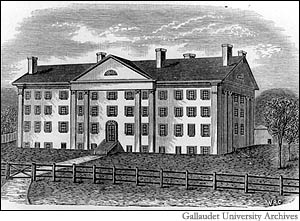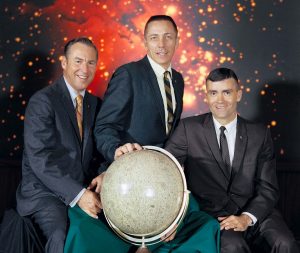During the 1800s, deaf people in America had no language they could use to communicate with other deaf people, or anyone else for that matter. They let others know their needs and wants through gestures and signs they came up with on their own. Some basic gestures, such as “yes” or “hungry,” were somewhat universal, but those signs only scratched the surface of what deaf people wanted to say. They were in need of their own language and of a way and a place to learn it, and although he was not deaf or hard of hearing, a man named Thomas Hopkins Gallaudet was the one who finally acquired it for them.
Thomas Gallaudet was a man of many talents. After graduating from Yale at seventeen, he worked as a law assistant and a tutor, but due to health-related issues, he left his job and became a door-to-door salesman in rural Kentucky and Ohio, where he schooled young children that couldn’t afford an education. He especially enjoyed teaching geography, U.S. history, and the Bible, which eventually lead to him discovering his own passion for religion. He earned his license to be a preacher, and became a traveling minister, going everywhere he felt there was a need. His constant traveling allowed him to visit his family in his hometown of Hartford, Connecticut on a regular basis.1

During one of his visits home, Gallaudet came across his neighbor’s daughter, Alice Cogswell, playing by herself. At the age of two, Alice had contracted meningitis, and as a result, lost her hearing.2 Her father, Dr. Mason Fitch Cogswell, explained to Gallaudet that his daughter was deaf and that she had trouble communicating with not only other children but also with her own family. Knowing that Gallaudet was a teacher, Dr. Cogswell pleaded with Gallaudet to help Alice learn how to speak, regardless of whether it was with her voice or her hands.3
Gallaudet agreed, and started teaching a simple form of sign language as best as he could. Nevertheless, both Gallaudet and Dr. Cogswell were deeply concerned with the lack of deaf education in America and set out to change that. The two them collected donations and support from their community, and soon enough, they had sufficient funds to send Gallaudet to Europe, to track down a sign language teacher.4
During his travels, Gallaudet came across an advertisement for a speech given by Abbe Sicard, the principal of a deaf institution in Paris, France. Gallaudet had previously known about him and his work, so he attended one of his speeches. After the speech, Gallaudet approached Sicard, and spoke to him about his troubles and worries over deaf education in America. Sicard listened intently to his woes and made the decision to invited Gallaudet to the institution he taught at, to take lessons under him. Gallaudet zealously accepted the offer, and went off to Paris with Sicard.5
In addition to taking classes with Sicard, Gallaudet also took private lessons with Sicard’s chief assistant, Laurent Clerc. Gallaudet was entranced by Clerc’s expertise in the sign language and begged him to come to America to teach with him. Clerc was skeptical, but Gallaudet was adamant. He worked hard to get Clerc onboard with his plan. Clerc eventually gave in and sought permission from Sicard to take a leave for his journey to America. Sicard was also initially wary of Clerc’s expedition, but also came around to the idea and granted Clerc the permission he asked for.6

On June 18, 1816, Gallaudet and Clerc set out for Hartford, Connecticut on the ship Mary Augusta, a journey that lasted fifty-two days. The two men used that time to exchange their knowledge of languages. Clerc continued teaching Gallaudet the vast array of signs that were included in French Sign Language, and Gallaudet helped Clerc to polish his English-speaking skills. On August 22, 1816, the day the Mary Augusta arrived in America, Laurent Clerc met Alice Cogswell for the first time. Although she did not know French Sign Language, Clerc “communicated with her through sign associations.” Clerc saw Alice had a strong will to continue to learn sign language, which fueled him in his quest to teach the deaf people of America a standardized nonverbal form of communication.7
Over the next couple of months, Gallaudet and Clerc traveled the United States. They spread information about sign language and deaf culture, met with potential students and their parents, and they began the process of establishing the first deaf school in America. They collected funds by taking donations from the public and from the Connecticut General Assembly also. They raised over $15,000 and they used that money to start what was “originally called the Connecticut Asylum at Hartford for the Instruction of Deaf and Dumb Persons (now the American School for the Deaf).”8 On the day of April 15, 1817, a little less than a year since Gallaudet brought Clerc to the United States, the school opened its doors to the public. Laurent Clerc was the first teacher and Alice Cogswell was the first student. The French Sign Language Clerc taught to his students eventually evolved to the dialect that deaf Americans still use today, American Sign Language.9

Although the school was good, Gallaudet and Clerc wanted to keep going. They went to Congress and got approval from the House of Representatives, Senate, and President Abraham Lincoln to granted college degrees from their school. Eventually, the American School for the Deaf branched out to form Gallaudet University, the first and only all-deaf university in the United States.10 Both the American School for the Deaf and Gallaudet University continue to provide proper education to those who are deaf and hard of hearing, proving a saying that prevails in deaf culture: Deaf people can do EVERYTHING a hearing person can do except hear.
- Katalin Enders, “Gallaudet, Thomas Hopkins,” 2003, Learning to Give (website), https://www.learningtogive.org/resources/gallaudet-thomas-hopkins. ↵
- “Alice Cogswell,” Scholastic. April/May 2012. ↵
- Carolyn Ball, The History of American Sign Language Interpreting Education (Minnesota: Capella University, 2007), 11. ↵
- Loida R. Canlas, “Laurent Clerc: Apostle to the Deaf People of the New World,” 2015, Gallaudet (website), http://www3.gallaudet.edu/clerc-center/info-to-go/deaf-culture/laurent-clerc.html. ↵
- Margret A. Winzer, The History of Special Education: From Isolation to Integration (Washington D.C.: Gallaudet University Press, 1993), 101. ↵
- Margret A. Winzer, The History of Special Education: From Isolation to Integration (Washington D.C.: Gallaudet University Press, 1993), 101. ↵
- Loida R. Canlas, “Laurent Clerc: Apostle to the Deaf People of the New World,” 2015, Gallaudet (website), http://www3.gallaudet.edu/clerc-center/info-to-go/deaf-culture/laurent-clerc.html. ↵
- Loida R. Canlas, “Laurent Clerc: Apostle to the Deaf People of the New World,” 2015, Gallaudet (website), http://www3.gallaudet.edu/clerc-center/info-to-go/deaf-culture/laurent-clerc.html. ↵
- Marc Marschark and Patricia E. Spencer, Oxford Handbook of Deaf Studies, Language, and Education (Oxford: Oxford University Press, 2003), 13-14. ↵
- Loida R. Canlas, “Laurent Clerc: Apostle to the Deaf People of the New World,” 2015, Gallaudet (website), http://www3.gallaudet.edu/clerc-center/info-to-go/deaf-culture/laurent-clerc.html. ↵



61 comments
Breanna Perry
It was very interesting to learn of the origin of American Sign Language. I honestly wish I would’ve had the opportunity to learn sign language at some point in my education. I think it’s something everyone should know, because it is so important to make the deaf feel as much a part of society as they truly are. What Gallaudet did was truly wonderful for those who are deaf, and I’m glad I know now of how ASL came to be.
Judy Reyes
I cannot believe that there was a time where the deaf were unable to communicate with each other. It is so great to know that there were men like Thomas Gallaudet and Laurent Clerc to make a difference for the deaf community. The awesome thing about it is that neither of them were deaf. They truly made a difference by starting the first all deaf school along with the first and only all deaf University.
Nicholas Robitille
I was surprised to see how american sign language had such an early origin. I had always thought that it was something developed in the 1900’s. I can see how it would be quite the problem for deaf people of America to be unable to communicate at this time, but I find it quite interesting that Gallaudet was able to take a prior language (French Sign Language), and convert it into a new language of its own, much like modern languages and Latin. Overall, this was a very fascinating and informative article that helps give context on the emergence of an entirely new language, something that is always interesting to see.
Daniel Ramirez
I find it really fascinating the life Thomas Gallaudet was living before he realized his calling for helping those who were hard of hearing or deaf. And despite having no experience in American sign language previously, he completely dived in and wanted to educate himself in the topic after meeting his neighbor’s deaf daughter. I also love he upon learning about this issue of learning sign language, he became an advocate, spreading his newly obtained knowledge. And best of all, I really like how he encourages all that a deaf person can do anything an ordinary hearing person can.
Angely Noriega Baron
After reading this article I was fascinated by Thomas Gallaudet’s work on helping multiple people with sign language. I had no idea how sign language was originated until I read this article on Gallaudet. Something that stood out to me was that Gallaudet and Laurent Clerc traveled the United States to spread information about sign language and deaf culture and began the process of establishing the first deaf school in America. They both believed that deaf people were able to do everything anyone else was able to do except hear.
Thalia Romo
The back story as to how American Sign Language came to be is highly interesting. I find it fascinating how Thomas Gallaudet was deeply devoted to helping those who couldn’t hear. To hear of how it came from a mere idea to an actual institution just from passion and determination is satisfying. I enjoyed how this article mentions of the first deaf student to be enrolled into Connecticut Asylum at Hartford for the Instruction of Deaf and Dumb Persons.
Cassandra Sanchez
Sign language is an important language to many and it was really fascinating to learn about how it came about in America. It is truly incredible how these men created a way to give a voice to those who are struggling for theirs to be heard. I find it amazing how these men continued helping deaf people by creating schools for them and even a university so that they can continue their education and receive many more great opportunities throughout their lives.
Aaron Peters
I was surprised to hear that most of American Sign Language could be contributed to the work of a few men. I assumed it naturally developed like most spoken languages, like English or French. It was really interesting how some of the signage came from French Sign language, as Gallaudet brought parts of that with him when he crossed the Atlantic.
Stephanie Cerda
I’ve never heard of the origins of American Sign Language. It’s really interesting and eye opening to read about a time when deaf people weren’t able to communicate as well and when not being able to hear was seen as a disadvantage. I’m glad now many ASL signs are common, and people are understanding, and even people who can hear learn it! It’s just like any other language. Gallaudet and Clerc helped children and people in their times a lot,, and the made a positive impact on people today as well.
Amanda Uribe
This is a topic that I had absolutely no prior knowledge going into and I loved hearing how Gallaudet was able to help create a voice for people who are deaf. I took a course on sign language and I never thought about where the origins of it were from. I think that we need more people like Gallaudet in the world.